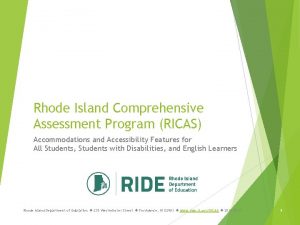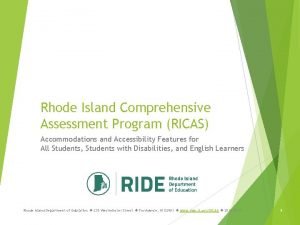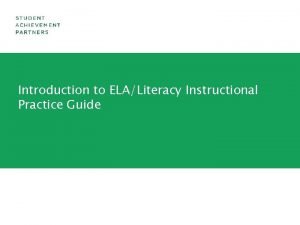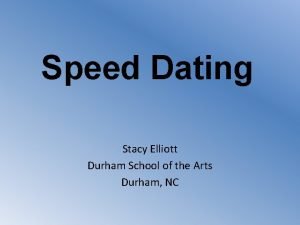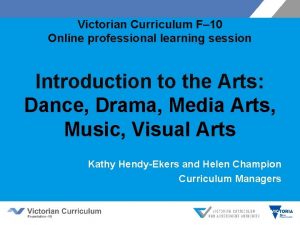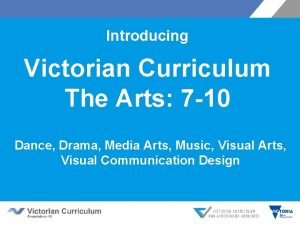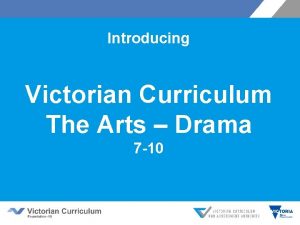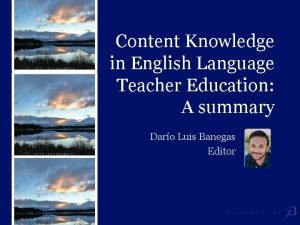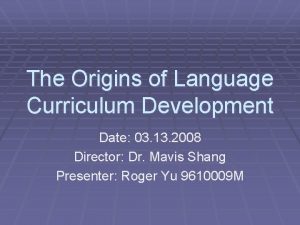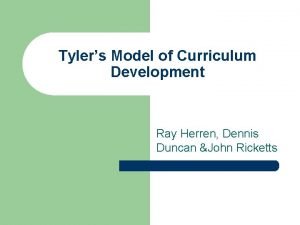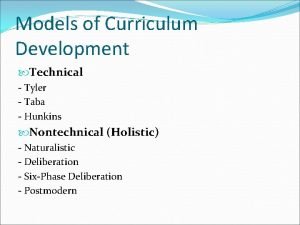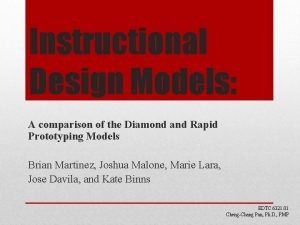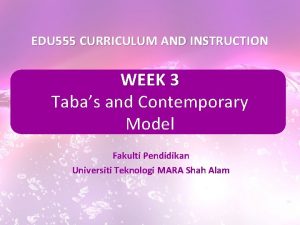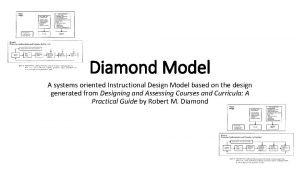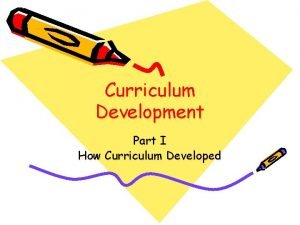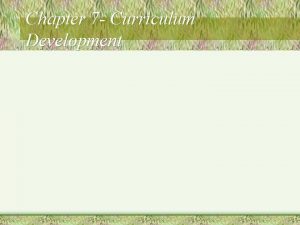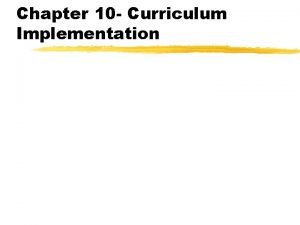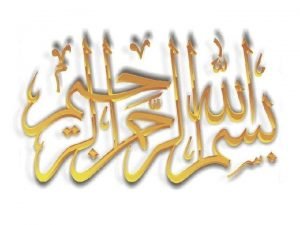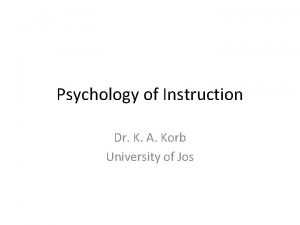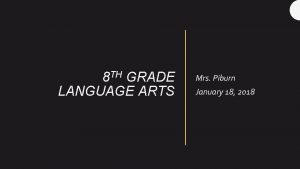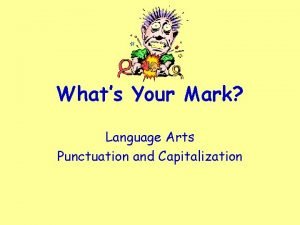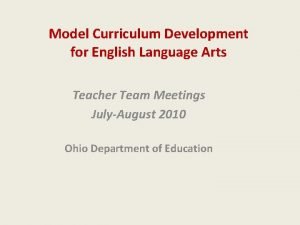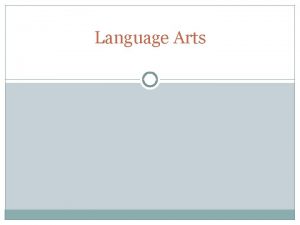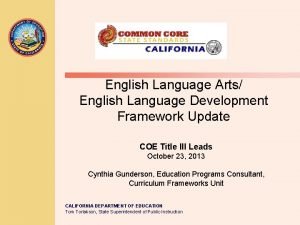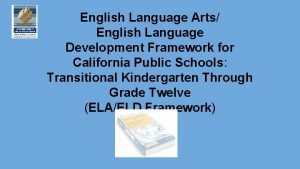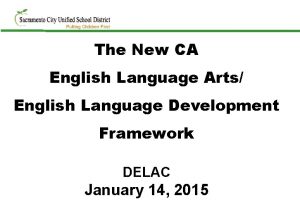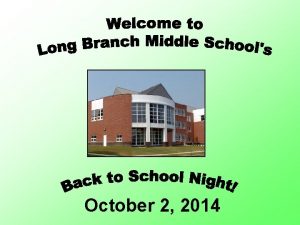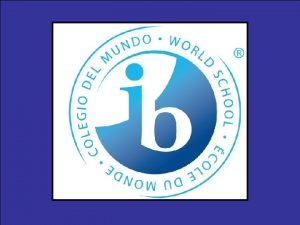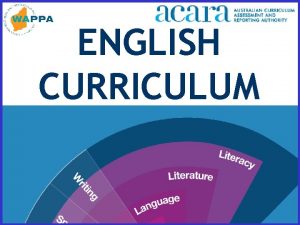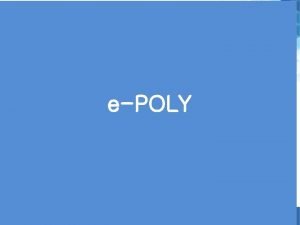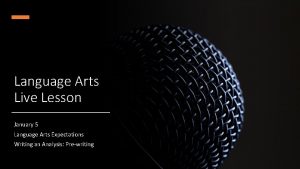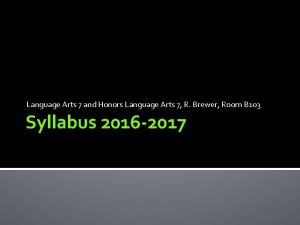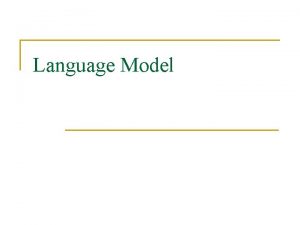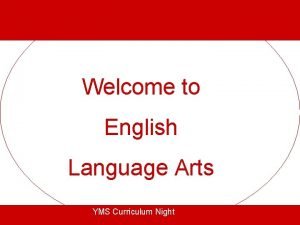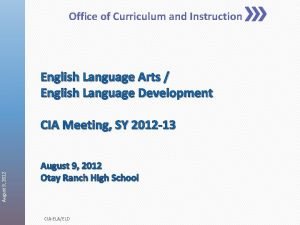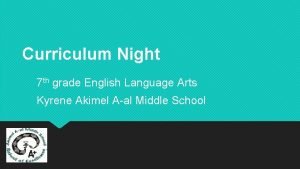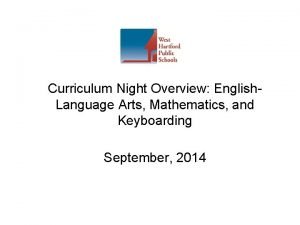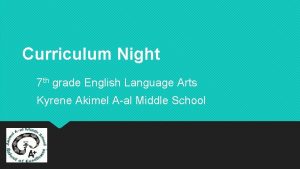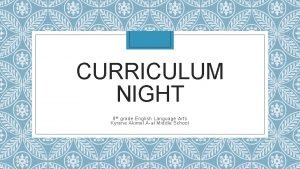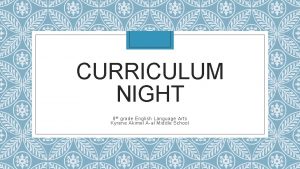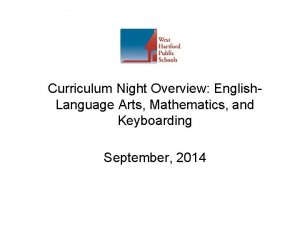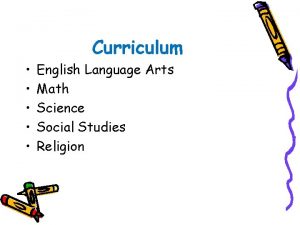Model Curriculum Development for English Language Arts Teacher

























- Slides: 25

Model Curriculum Development for English Language Arts Teacher Team Meetings July-August 2010 Ohio Department of Education

Goals for this Session You will have an: § understanding of the Common Core State Standards for English Language Arts; § understanding of the model curriculum; and § opportunity to collaborate with fellow educators and suggest instructional strategies and resources for the model curriculum.

Standards Revision Not later than June 30, 2010…the 2010… state board of education shall adopt statewide academic standards with emphasis on coherence, focus, and rigor for each of grades kindergarten through twelve in English language arts, mathematics, science, and social studies. ORC § 3301. 079(A)(1)

Standards Adoption By June 30, 2009 English language arts Mathematics Science Social Studies Common Core Standards State Standards

Common Core State Initiative • State adoption – Voluntary – State Board of Education adoption- June 7, 2010 • 100% of the common core K-12 standards in English and mathematics to be adopted • In its entirety or up to 15% state-specific content added • Next steps: Consortia of states will be encouraged to develop assessments & curricular materials

ELA Common Core Standards Framework Strands “What” students should know and be able to do at each grade level and band. Topics Standard Statements by Grade Level Standards Statements by Grade Level The major areas or disciplines of study within each content area. The main focus of the content within each strand. Standards Statements by Grade Band

ELA Common Core Standards Framework Reading Standards for Literature Key Ideas and Details Gr. 2 Describe how characters in a story respond to major events and challenges. Gr. 6 Describe how a particular story’s or drama’s plot unfolds in a series of episodes as well as how the characters respond or change as the plot moves toward a resolution. Gr. 9 -10 Analyze how complex characters (e. g. , those with multiple or conflicting motivations) develop over the course of a text, interact with other characters, and advance the plot or develop theme.

The ELA Common Core State Standards Document also includes: • • • Anchor standards Grade level and grade band expectations Text complexity Illustrative texts Language Progressive Skills, by Grade Literacy standards for History/Social Studies, Science and other Technical Subjects(Grades 612)

Components of Common Core ELA Standards Common Core Strand Reading Strand a. Reading Standards for Literature b. Reading Standards for Informational Text c. Reading Standards: Foundational Skills Topics within Strands Key Ideas and Details Craft and Structure Integration of Knowledge and Ideas Range of Reading and Level of Text Complexity Print Concepts Phonological Awareness Phonics and Word Recognition Fluency

Writing Strand Text Types and Purposes Production and Distribution of Writing Research to Build Knowledge Range of Writing

Speaking and Listening Strand Comprehension and Collaboration Presentation of Knowledge and Ideas

Language Strand Conventions of Standard English Knowledge of Language Vocabulary Acquisition and Use

MODEL CURRICULUM

Model Curriculum …the state board shall adopt a model curriculum…The model curriculum shall be aligned with the standards, to ensure that the academic content and skills specified for each grade level are taught to students, and shall demonstrate vertical articulation and emphasize coherence, focus, and rigor. ORC § 3301. 079(B)

Model Curriculum A web-based tool for educators which • aligns to the standards; • provides curricular and instructional guidance; • informs assessment development; • presents information specific to the content area; • is accessible directly from the standards; and • allows teachers to access content by subject area, grade level, grade band or course.

Elements of the Model Curriculum Ø Content Elaborations Ø Instructional Strategies and Resources q Differentiated classroom ideas q Critical Thinking and Inquiry q Intradisciplinary and Interdisciplinary Connections Ø Content Specific Sections(e. g. , enduring understandings) Ø Expectations for Learning(only science and social studies)

Enduring Understandings • Statements summarizing important ideas and core processes that are central to a discipline and have lasting value beyond the classroom. • They synthesize what the students should understand. • They frame big ideas that give meaning and lasting importance to such discrete curriculum elements as facts and skills. • They can transfer to other fields as well as adult life • They provide a conceptual foundation for studying the content area • They are deliberately framed as declarative sentences that present major curriculum generalizations and recurrent ideas

Example of an Enduring Understanding Reading/Literature: “Reading is a process by which we construct meaning about the information being communicated by an author within a print or non-print medium. ”

Strand Reading Informational Text Topic Key Ideas and Details Grade 9 -10 Standard Statement(s) 1. Cite evidence in the text that most strongly supports a specific analysis of what the text says explicitly as well as inferences drawn from the text. 2. Analyze in detail the development and refinement of a central idea in a text, including how it emerges and is shaped and refined by specific details. 3. Analyze the interactions between and among ideas and events, including how ideas and events influence one another. Content Elaborations • Informational and argumentative texts can advance opinions, justify positions and make judgments in order to inform and persuade the reader. • Creators of text carefully position the details which support the main idea in such a way so that the reader is most influenced by what the text states explicitly and implicitly. • Readers and viewers of text may need to develop knowledge about particular events, issues and contexts to interpret the subject matter of texts. Enduring Understandings • Making judgments about the ideas found in text requires that students understand both the explicit and implicit ideas that are presented in the text. • Explaining and supporting personal connections to text requires that students are able to analyze the interactions between and among ideas and events in the text. Content Specific Section Instructional Strategies and Resources • Have students participate in setting purposes for reading by Resources using anticipation guides. (This guide then becomes a powerful tool for assessing learning or changed attitudes after reading and discussion as well). • In preparation for a reading on bacteria and viruses in a biology class, for example, students might be asked to respond to statements such as “A typical square inch of human skin hosts thousands of bacteria”. Students could then assess their beliefs after reading the article or chapter, noting the sections in the text that influences their thinking. Critical Thinking and Inquiry Scaffolding Engagement With a 19 th-Century Text – http: //www. readwritethink. org/classroom-resources/lessonplans/reaching-across-time-scaffolded-1179. html Differentiation Using Podcasting as a Prereading Strategyhttp: //ohiorc. org/adlit/In. Perspective/Issue/200704/Article/vignette 1. aspx

Content Review Committees • Committee members will collaborate with the ODE to inform the development of: – Content Elaborations – Expectations for Learning – Content Specific Sections • Review committees meet from June– September 2010 • ODE will facilitate these meetings

Stakeholder Input • Teacher Team meetings – Collection of Instructional Strategies and Resources – 44 -46 meetings per region across the four content areas • Review committees – Development of the Content Elaborations and Enduring Understandings – Content experts from across the state • Public Feedback – All components of the model curriculum – Educators and non-educators across the state

Timeline for ELA Model Curriculum Development of the Content Elaborations and Enduring Understandings. Public feedback integrated into Model Curriculum Regional teacher teams generate Instructional Strategies and Resources ELA, Mathematics, Science, and Social Studies Standards Adopted 2010 Public feedback on Model Curriculum State Board adopts Model Curriculum Final draft released 2011

Anticipated Timeline for Transition to New Comprehensive Educational System State Board Adopts Model Curriculum Common Core Standards Adopted 2010 2011 Planning for Transition; Field Testing for New Assessments 2012 Planning for Transition; Standard Setting for Assessments 2013 Implementation of New Assessments 2014 2015

Model Curriculum • Content Elaborations • Expectations for Learning • Content Specific Sections Content Review Committees Model Curriculum Teacher Teams Instructional Strategies and Resources Common Core and State Standards Nationally and State Developed

Thank You
 Creative arts grade 8
Creative arts grade 8 Rhode island comprehensive assessments system
Rhode island comprehensive assessments system Ricas accommodations
Ricas accommodations Instructional practice guide
Instructional practice guide Mrs elliott a teacher at durham school of the arts
Mrs elliott a teacher at durham school of the arts Victorian curriculum visual arts scope and sequence
Victorian curriculum visual arts scope and sequence Dance curriculum victoria
Dance curriculum victoria Victorian curriculum visual arts
Victorian curriculum visual arts Victorian curriculum drama
Victorian curriculum drama Banegas initial english language teacher education download
Banegas initial english language teacher education download The origin of language curriculum development
The origin of language curriculum development Hilda taba 1962 model
Hilda taba 1962 model Tyler model curriculum development
Tyler model curriculum development Advantages of tyler's objective model
Advantages of tyler's objective model Diamond model of curriculum development
Diamond model of curriculum development Weaknesses of taba model
Weaknesses of taba model Systematic design model by robert diamond
Systematic design model by robert diamond Example of taba model
Example of taba model Models in curriculum development
Models in curriculum development Organizational development model in curriculum
Organizational development model in curriculum Requirements for teacher 3 erf
Requirements for teacher 3 erf Good afternoon student
Good afternoon student Obe in education
Obe in education Teacher centered curriculum
Teacher centered curriculum Language arts
Language arts When do we use question mark
When do we use question mark

